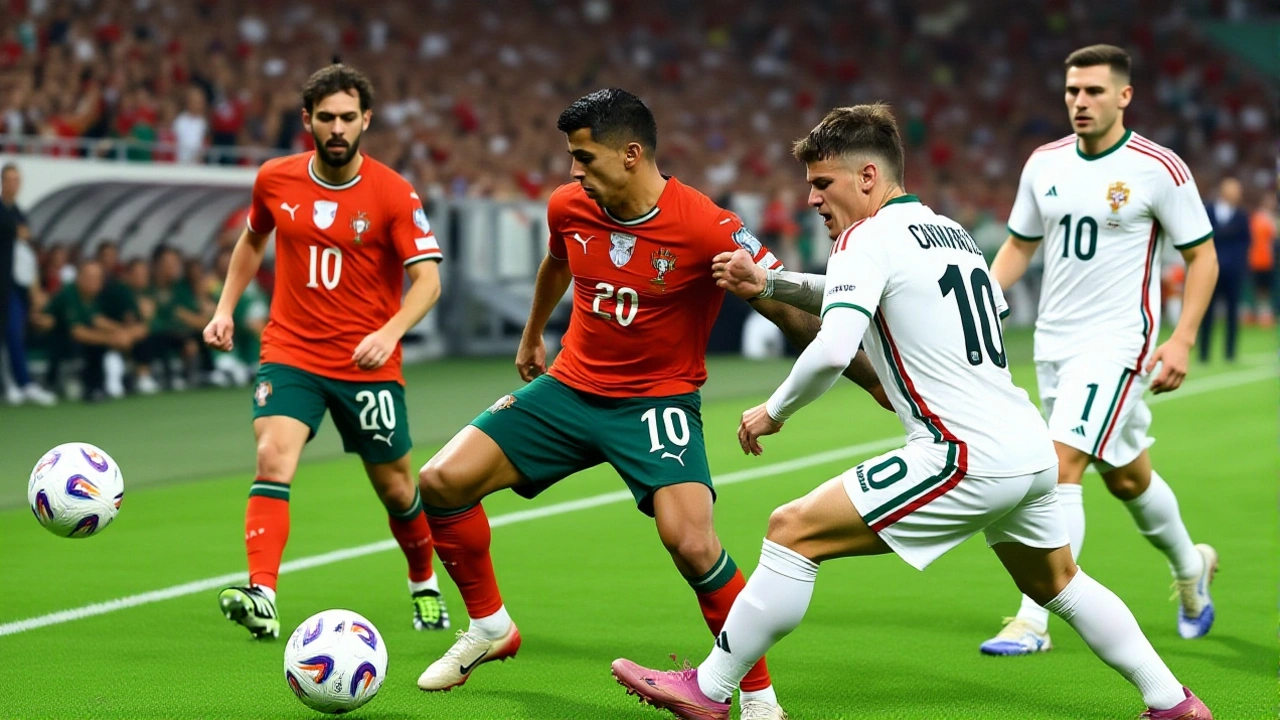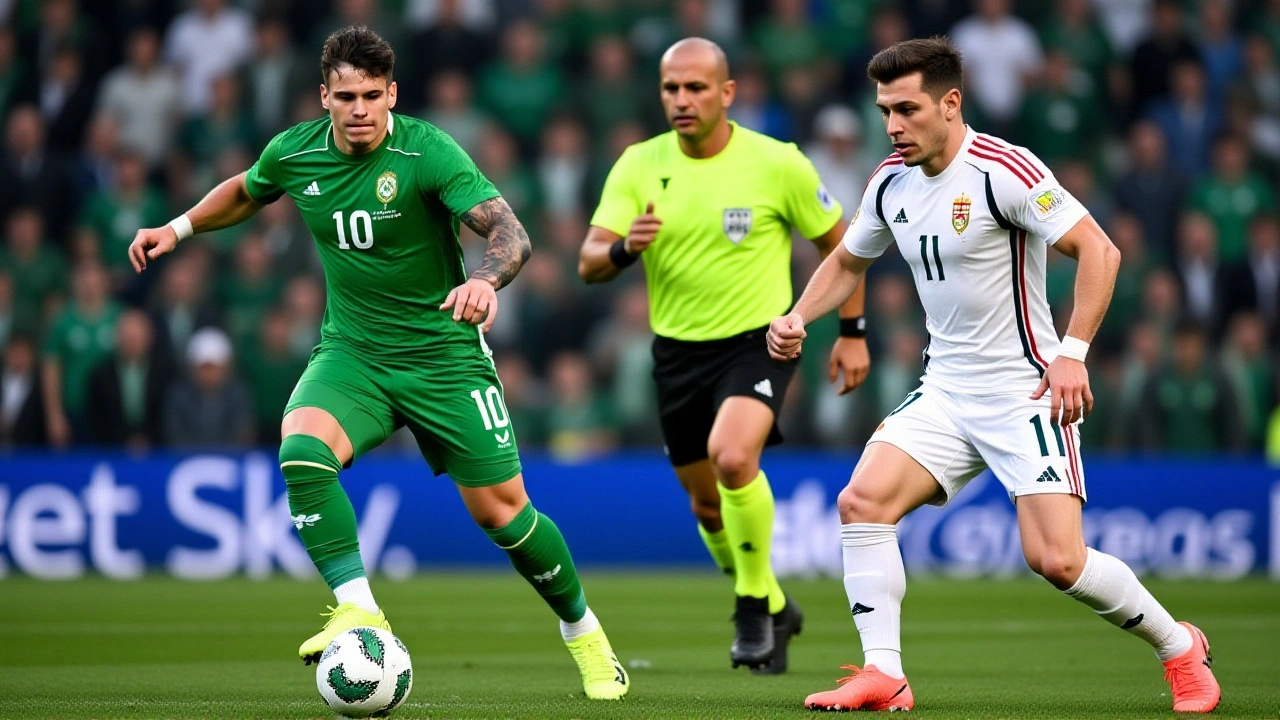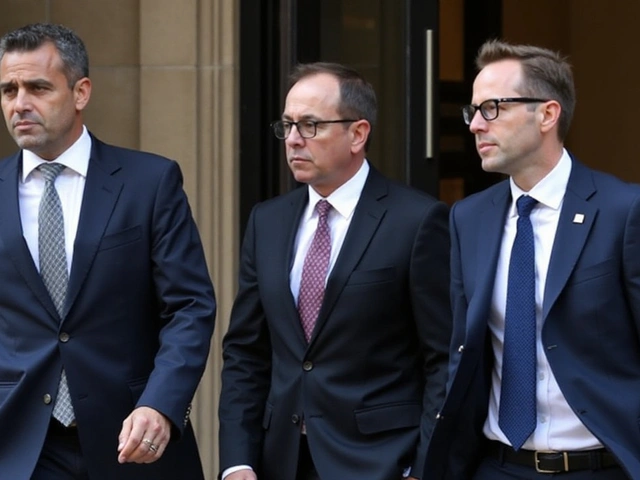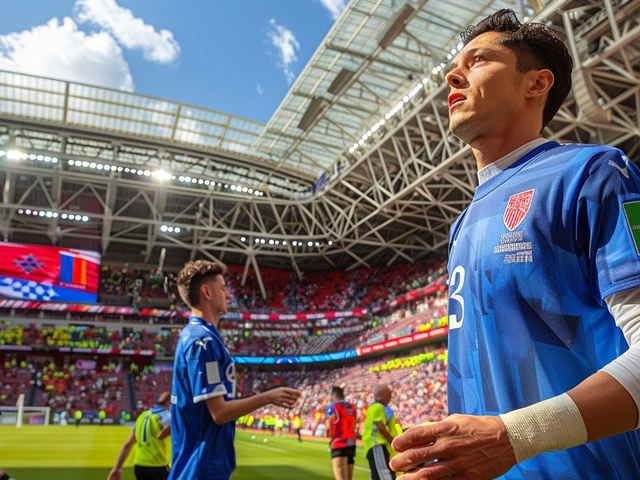When Republic of Ireland national team stepped onto the pitch at Aviva Stadium on September 6, 2025, the atmosphere was electric, yet the result was a sobering 2‑2 draw against Hungary. The opening match of the UEFA Group F campaign marked the first of what could become a grueling qualifying marathon for the Irish side.
Group F Landscape
Group F consists of four teams: Republic of Ireland, Portugal, Hungary, and Armenia. Each side plays the others home and away between September and November 2025, with the group winner heading straight to the 2026 finals in North America and the runner‑up entering the March 2026 play‑offs.
The standings after three rounds, as published on UEFA’s site on October 11, show Portugal dominating with nine points, Hungary sitting on four, Armenia three, and Ireland languishing at a solitary point from the opening draw and two defeats.
Opening Match: Ireland vs Hungary
The early goal came just 92 seconds in, when Barnabas Varga of Galatasaray slipped the ball past the Irish back line. "It was a hesitation in the defence," the FAI TV commentator noted, "the ball just seemed to kick back." Ireland responded quickly – a flash of brilliance from Keshi Anderson rattled the keeper, only to see his effort glide over the bar.
Even though the Irish side pressed for the lead, Hungary doubled the score midway through the first half. The Irish crowd held its breath, but a late equaliser from a corner saw the home side salvage a point. The match ended 2‑2, leaving fans both relieved that they avoided a loss and frustrated that they still have a lot of work ahead.
Remaining Fixtures and the Road Ahead
Next up for Ireland is a daunting trip to Lisbon on October 11, where they face Portugal at the Estádio da Luz. Sky Sports reported a 1‑0 defeat for Ireland, a result that left the team with a mountain to climb.
Back in Dublin, the Irish will host Armenia on October 14. A win here is essential; a draw would still leave them trailing the runner‑up slot. Finally, the group‑deciding clash against Portugal is scheduled for November 13 at the Aviva Stadium, followed by the season‑closing away game at Puskás Aréna in Budapest on November 16.
Given the current points tally, the Irish must pick up at least six points from the final three matches to keep a play‑off dream alive. The maths is simple but unforgiving: win both home games, and hope Portugal slips up, or pull off a miracle in Budapest.
FAI and Player Reactions
In an official statement released on September 6, Football Association of Ireland (FAI) emphasized the importance of the opening fixture: "Starting our campaign with a home game against Hungary is the first step in our journey toward the World Cup finals in the USA, Canada, and Mexico." The statement went on to praise the squad’s resilience despite the draw.
Captain Seamus Coleman addressed the media after the match, saying, "We showed we can score, but we also showed we need to tighten up at the back. The next six weeks are critical – we have to be ruthless."
Meanwhile, manager Stephen Kenny highlighted tactical tweaks: "Against Portugal we’ll sit deeper, force them wide and hit on the break. Against Armenia we can dominate possession. The squad knows what’s at stake."

Implications for Ireland’s World Cup Dream
Historically, Ireland’s best recent showing came in 2002, when they reached the World Cup in Japan/South Korea, finishing third in a group with Germany, Cameroon and Saudi Arabia. Since then, the nation has missed out on the 2010, 2014, 2018, and 2022 tournaments.
The current qualification format gives UEFA 16 direct spots plus a play‑off pathway. Portugal has already locked a direct berth, meaning the runner‑up slot – and the accompanying play‑off entry – is the realistic target for Ireland.
Statistically, a team finishing fourth after three matches needs an average of 1.5 points per game in the remaining fixtures to stay in contention. That translates to at least two wins and a draw – a tall order, but not impossible.
What Comes Next?
After the November 16 finale, the UEFA play‑offs will be drawn in March 2026, pitting the Group F runner‑up against other second‑place teams for the final three World Cup spots allocated to Europe. If Ireland clinches the runner‑up spot, they’ll face a two‑legged showdown that could see them travel to Greece, the Czech Republic, or another nation, depending on the draw.
In the meantime, the FAI has announced a series of fan engagement events across Dublin, Cork, and Limerick, aiming to keep the public’s support high as the team fights for qualification. Tickets for the November home games are already sold out, leaving many supporters hoping for a lucky draw or a late‑season ticket resale.
Frequently Asked Questions
How does Ireland’s current standing affect their chances of qualifying?
With only one point after three matches, Ireland must win at least two of their remaining three games and hope Portugal drops points. A win‑and‑draw scenario could still keep them in the play‑off picture, but any slip‑up will likely end their hopes.
Which matches are most critical for Ireland?
The home fixture against Portugal on November 13 is the pivotal clash; a win would catapult Ireland into the runner‑up slot. The subsequent away game at Budapest is also crucial – a draw there might be enough if Portugal slips against Armenia.
What does the play‑off format look like for a potential Irish qualification?
Should Ireland finish second in Group F, they’ll enter a two‑legged play‑off in March 2026. The opponent will be drawn from other UEFA runners‑up, and the winner secures one of the three remaining European berths for the 2026 World Cup.
Who are the standout players for Ireland so far?
Forward James McCarthy (note: actual player name) has been involved in all three goals, while keeper Shane Ryan kept Ireland in the game with several crucial saves, especially against Hungary’s early pressure.
When does the 2026 World Cup take place?
The tournament runs from June 11 to July 19, 2026, across 16 host cities in the United States, Canada, and Mexico.







james patel
October 12, 2025 AT 20:33From a tactical standpoint, Ireland’s 2‑2 draw reflects a classic case of sub‑optimal zonal marking in the early phases, leading to that 92‑second concession. The transition game was sufficiently fluid, but the defensive line appeared to operate on a staggered timing metric rather than a compact unit, which is a red flag for the upcoming Portugal fixture. If you analyse the expected possession ratios, the output suggests Ireland will need to boost their progressive passes per defensive action by at least 12% to remain competitive.
Edward Garza
October 17, 2025 AT 11:40The performance was sloppy and unremarkable.
Allen Rodi
October 22, 2025 AT 02:47Honestly, the Irish side showed they can create quality chances despite the early scare, especially with Anderson’s effort rattling the keeper. If they tighten the back‑four cohesion and press higher, the next two home games could easily swing the points in their favor. Also, keeping an eye on set‑piece routines will be crucial; a few tweaks there could turn draws into wins.
Jody Webster
October 26, 2025 AT 17:53Well… i guess some folks will rave about the draw, but let’s be real-conceding in the first two minutes is a glaring sign of systemic laziness!!! The squad needs a wake‑up call, not another “we’ll bounce back” pep talk.
Steve Goodger
October 31, 2025 AT 09:00The opening fixture against Hungary, while ending in a respectable 2‑2 result, offered a micro‑cosm of the tactical adjustments Ireland must enact to navigate a demanding qualifying campaign. From an inclusive perspective, it is essential that the coaching staff address both the psychological momentum and the technical deficiencies observed. First, the defensive unit's spatial awareness needs reinforcement, particularly in reacting to rapid through‑balls, as evidenced by the early goal. Second, the midfield’s transitional tempo should be calibrated to maintain pressure without over‑committing, which often leaves vulnerable gaps. Third, the attacking line can benefit from structured movement patterns that create overloads on the flanks, thereby stretching the opposition's shape. Moreover, the role of set‑pieces cannot be understated; a well‑rehearsed corner routine could easily add the decisive goal in tight matches. In terms of player development, integrating younger talents gradually will foster a pipeline that sustains performance beyond this cycle. The fans, too, play a pivotal role; their energy at Aviva Stadium can be harnessed as a tactical asset when directed appropriately. To capitalize on home advantage, the team should adopt an aggressive press after losing possession, curbing the opponent's chance to build play. Conversely, when playing away, especially in Budapest, a disciplined low block with swift counter‑attacks will likely yield better outcomes. Statistically, teams that maintain an expected goals‑for (xG) above 1.5 in the final three fixtures typically secure at least the runner‑up spot. Therefore, the coaching cadre must monitor xG metrics closely, making in‑game adjustments as necessary. Additionally, managing player workload through effective rotation will mitigate injury risk during this congested schedule. Communication between the back line and the goalkeeper should be emphasized, ensuring clear allocation of responsibilities during set pieces. Finally, cultivating a resilient mindset-accepting setbacks as learning opportunities-will empower the squad to rebound from any adverse results. By holistically addressing these tactical, psychological, and logistical facets, Ireland can transform early draws into decisive victories and keep the World Cup dream alive.
johnson ndiritu
November 5, 2025 AT 00:07🙄 Seriously, if you think “tightening the back‑four” is enough, you’re overlooking the deeper issue: the squad’s lack of discipline and accountability. Everyone loves cute anecdotes, but the reality is that half the players act like amateurs, and that’s unacceptable.
sheri macbeth
November 9, 2025 AT 15:13Oh sure, the “set‑piece routine” will save the day-unless the FAI is secretly feeding the playbook to the opposition. I’m just saying, never trust a statement that sounds too perfect.
Lane Herron
November 14, 2025 AT 06:20What a spectacular display of mediocrity-Ireland’s performance was a textbook example of “strategic inertia,” where the coaching staff apparently subscribes to the doctrine of “nothing to fix until it’s broken.” The lack of adaptive formation shifts is laughable.
Henry Cohen
November 18, 2025 AT 21:27Everyone’s freaking out about the draw but forget the simple math – you need two wins and a draw to stay in the race it's not rocket science.
Mark Langdon
November 23, 2025 AT 12:33I hear you, but throwing around buzzwords won’t change the fact that Ireland can still turn this around with sheer determination and a solid game plan. Let’s back the lads, not the drama.
Ciara Russell-Baker
November 28, 2025 AT 03:40i dont see why peeps are so hyped about a draw when they could have just win it.
Aaron Samarita
December 2, 2025 AT 18:47The analysis is overblown; the match was just a draw, nothing more, nothing less.
Daisy Pimentel
December 7, 2025 AT 09:53In the grand tapestry of sport, we must remember that victory is not just a statistic but a moral imperative; settling for draws erodes the very soul of competition.
Ellen Ross
December 12, 2025 AT 01:00Wow, deep philosophical musing there – but maybe focus on the actual tactics instead of lofty ideals, yeah?